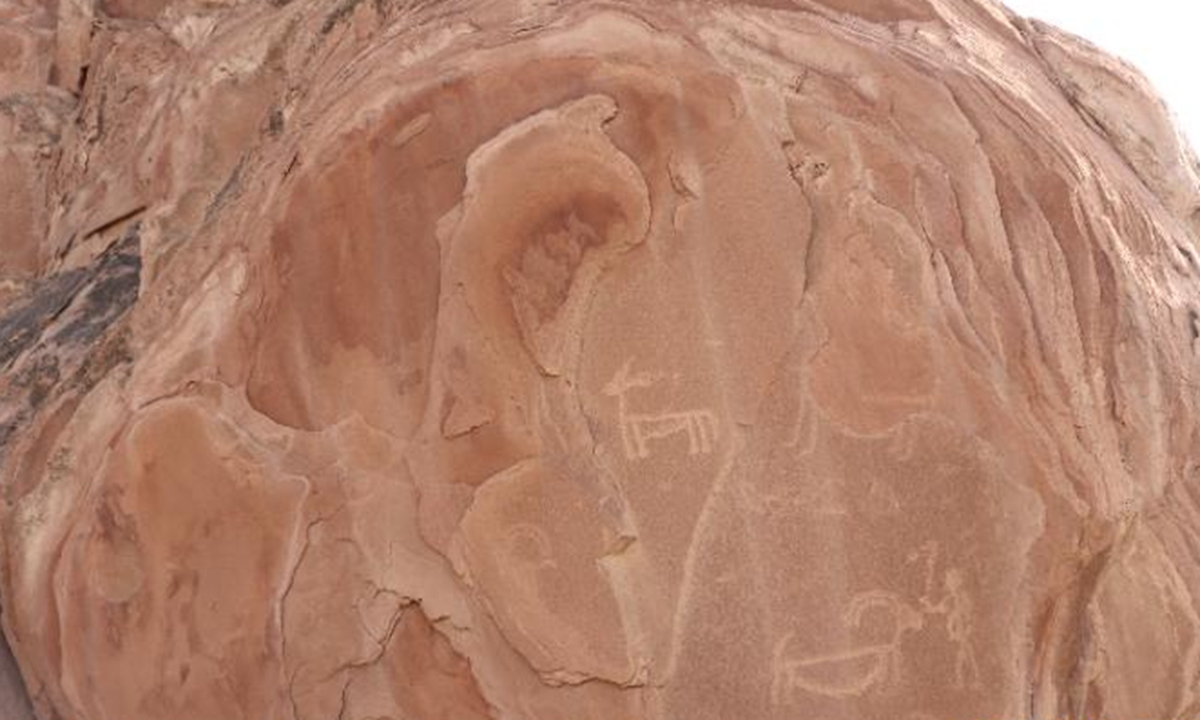
Photo: Xinhua
Two ancient rock paintings dating back 3,000 to 4,000 years have been discovered in Baiyin, Northwest China’s Gansu Province, the cultural relics survey team in the city’s Pingchuan district announced on Wednesday.
The paintings were found on a hillside on the east bank of the Yellow River, approximately two kilometers southeast of the Yuwanquan village in the Pingchuan district.
The discovery was made after the team received a report from a local resident on March 12 that led them to the site, Guo Mingchun, a member of the cultural relics survey team, told the Global Times.
The larger one of the two paintings measures 2.4 meters tall and 3.9 meters wide. It features a hound in motion at the center along with five other images of animals, including bighorn sheep and deer.
The second painting, located about five meters away, is 2.2 meters tall and 2.3 meters wide and has five images. Two of these images are well-preserved while the other three have suffered damage due to weathering. One particularly striking depiction shows a man wielding a whip to drive a pot-bellied sheep.
“This is the first time that an image of a pot-bellied sheep has been found in rock paintings here,” Guo told the Global Times. “We were all excited to see these paintings. It was like receiving a big gift from the ancients.”
Since the 1970s, multiple ancient rock painting sites have been discovered along the Yellow River in Gansu Province, including in Baiyin, Wuwei in the eastern part of the Hexi Corridor (a part of the ancient Silk Road), and Jiayuguan in the western part of the Hexi Corridor. These sites are often located in remote mountains, deserts, or river valleys and their original features are preserved, according to the Xinhua News Agency.
Guo told the Global Times that these artworks tend to appear in areas where water sources were once present and ancient populations may have settled.
“Generally, rock paintings are found in places where people lived near water sources. For example, in the Pingchuan district, many of the rock paintings we have discovered are located along the Yellow River,” she said.
However, these ancient rock paintings are mostly located in remote areas in Gausu, exposed to the elements, and scattered across various sites, making preservation and research challenging. To address this problem, the province has completed high-precision data collection for 72 rock art sites and established a digital image database, ensuring the historical information in these artifacts is preserved more comprehensively and efficiently, according to Xinhua.
“Northwest China, including Gansu Province, played a crucial role in the ancient Silk Road, facilitating migration and cultural exchange among diverse ethnic groups. Over the centuries, these interactions left behind a rich cultural heritage, including rock paintings,” Liu Zheng, a member of the Chinese Society of Cultural Relics, told the Global Times.
According to Liu, using easily obtained materials, ancient people “depicted their daily lives, production activities, and even beliefs” through rock art. “These rock paintings, as another form of historical record aside from written language, hold significant value in studying the social life, history and culture, and cultural exchanges of ancient civilizations,” Liu remarked.





